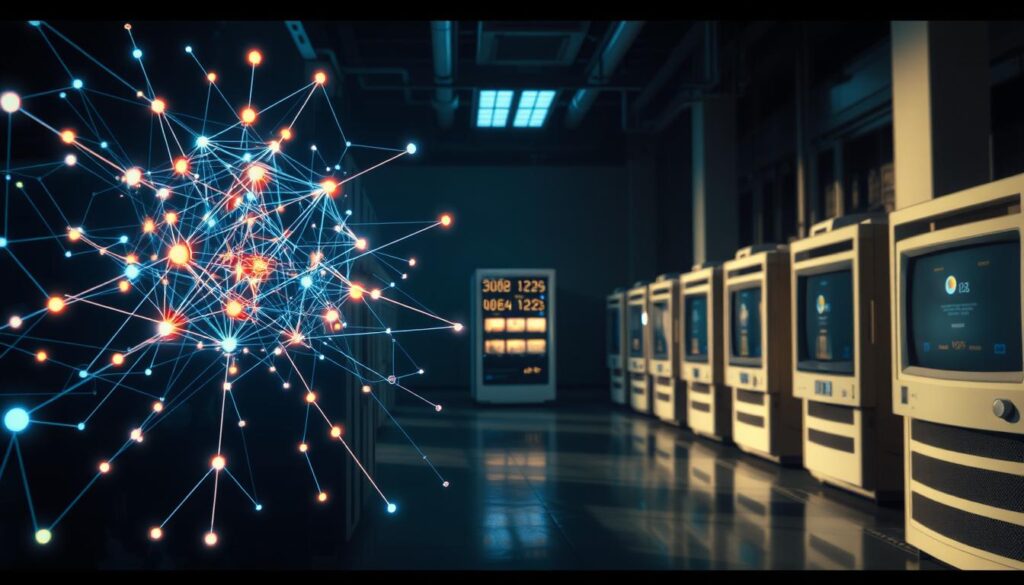Have you ever wondered how Deep Learning is changing Artificial Intelligence? This new tech uses advanced Neural Networks to look at big data. It's different from old Machine Learning ways.
As we dive into Deep Learning, we see its big role in many fields. It's key for new ideas and growth. It's changing healthcare, finance, and making things better.
Key Takeaways
- Deep Learning is a vital part of today's Artificial Intelligence.
- Neural Networks are key to getting Deep Learning.
- This tech goes beyond old Machine Learning in data analysis.
- Real-world uses show Deep Learning's big change.
- Deep Learning keeps opening up new chances in many areas.
The Rise of Deep Learning in Technology
Deep Learning has changed technology a lot in recent years. It's a big part of artificial intelligence. It helps many areas by understanding data like our brains do.
Deep Learning uses lots of data and special algorithms. It finds patterns and makes good guesses.
Understanding Deep Learning
Deep Learning uses neural networks that learn from data. These networks are like our brains. They have layers that get better at understanding data.
This method helps with things like recognizing pictures and understanding speech. It's very good at these tasks.
The Evolution of Neural Networks
Neural Networks have grown a lot over time. They started with simple models and got more complex. Now, they use special computers to work faster.
This growth in computers and data has helped a lot. It lets us make models that can handle lots of information.
| Aspect | Early Neural Networks | Modern Deep Learning Models |
|---|---|---|
| Architecture | Simple perceptrons | Deep multi-layer networks |
| Data Handling | Limited data processing | Big data analytics |
| Computational Power | Basic CPUs | Advanced GPUs |
| Application | Restricted scopes | Diverse industry applications |
How Deep Learning is Transforming Industries
Deep Learning is changing many industries. It's making old ways better and more efficient. It's helping in healthcare, finance, and making things.
Applications in Healthcare
In Healthcare Innovation, Deep Learning is big. It helps doctors find diseases early. It makes patient care better.
IBM Watson Health uses it to help doctors make better choices. This leads to better health and saves money.
Advancements in Finance
Deep Learning is key in Financial Advancements. Banks use it to spot risks and stop fraud. It helps them make smart trades.
JPMorgan uses AI to help make smart choices. This makes their money work better.
Enhancing Manufacturing Processes
In manufacturing, Deep Learning makes things better. It helps make things faster and more efficient. It also keeps machines running smoothly.
By using data, factories can work better. This gives them an edge in the market.
| Industry | Key Applications | Benefits |
|---|---|---|
| Healthcare | Medical image analysis, predictive modeling | Faster diagnoses, improved patient outcomes |
| Finance | Risk management, fraud detection, algorithmic trading | Enhanced decision-making, increased efficiency |
| Manufacturing | Automation, predictive maintenance, supply chain optimization | Reduced costs, improved productivity |
Key Components of Deep Learning Technology
Deep Learning technology has many parts working together. These parts help it process data in new ways. Knowing about these parts is key to using this technology well.
Neural Networks and Their Functionality
Neural networks are at the heart of Deep Learning. They work like our brains to understand data. They have layers for input, hidden, and output, each doing different things.
The input layer gets the data. Hidden layers do the hard work. The output layer shows what the network thinks.
Activation functions help the network learn. They decide what each neuron does. Loss functions check how well the network does. They help make the network better.
The Role of Algorithms in Machine Learning
Machine Learning Algorithms make Deep Learning work. There are special types like CNNs and RNNs. CNNs are great with images, finding patterns easily. RNNs are good with sequences, like time or language.
Knowing how these parts work together helps use Deep Learning in many fields.
Deep Learning vs. Traditional Machine Learning
In the world of artificial intelligence, Deep Learning and Traditional Machine Learning are key. Each has its own strengths for different challenges. Knowing their differences helps us choose the right tool for Use Cases.
Comparative Analysis of Approaches
Deep Learning uses complex algorithms in layers to handle big data. It's great for recognizing images or voices. Traditional Machine Learning works well with small data and simple problems. It uses algorithms like decision trees but struggles with complex data.
| Criteria | Deep Learning | Traditional Machine Learning |
|---|---|---|
| Data Requirements | Large datasets | Smaller datasets |
| Complexity | High complexity | Moderate complexity |
| Feature Engineering | Automatic feature extraction | Manual feature selection |
| Computational Power | Resource-intensive | Less resource-intensive |
| Best Use Cases | Image and speech recognition | Fraud detection, predictive modeling |
When to Use Deep Learning Over Machine Learning
Choosing the right method depends on the project needs. For big data like video or language, Deep Learning is best. Traditional Machine Learning is better for simpler tasks or quick solutions. Knowing this helps teams pick the right tech for their problems.

Natural Language Processing and Deep Learning
Natural Language Processing and Deep Learning have changed how machines talk to us. They use advanced Deep Learning NLP Techniques. This has made many things better, like how we talk to machines.
Techniques in NLP
Deep Learning has made Natural Language Processing better. It includes:
- Sentiment Analysis: It helps businesses know how people feel. This way, they can answer better.
- Language Translation: Tools like Google Translate use Deep Learning. They make translations more accurate.
- Text Summarization: It makes long texts short. This helps us remember more.
Impact on Communication Technologies
Deep Learning makes talking to machines better. Virtual assistants like Amazon Alexa get smarter. They can understand us better.
Chatbots also get better. They talk to us in a way that feels natural. This is because they learn from lots of data.
Together, Natural Language Processing and Deep Learning make talking to machines better. We are happier and communicate better because of it.
Computer Vision Powered by Deep Learning
Deep Learning has made Computer Vision much better. It uses things like Convolutional Neural Networks (CNNs). These help machines understand pictures in ways they couldn't before.
This new way of seeing pictures is changing many areas. It makes picture analysis better and helps machines do hard tasks on their own.
Image Recognition Revolution
Deep Learning has changed how machines see and understand pictures. CNNs can spot objects, faces, and even feelings. This is changing many fields.
It lets machines do things like sort pictures and watch videos live. This makes them work better in many areas.
Applications in Automotive and Robotics
In cars, Deep Learning helps with self-driving. It lets cars see signs, obstacles, and people. This makes driving safer and easier.
Robots also get better with Deep Learning. They can see things and move around better. This makes robots work more efficiently and safely.
Data Analysis Enhancements through Deep Learning
Deep learning is changing how we analyze data. It helps us find important insights in big datasets. This makes a big difference in making decisions.
Uncovering Insights from Big Data
Today, businesses have a lot of data. Deep learning helps find useful information in this data. It uses smart neural networks to spot patterns we might miss.
This way, companies can learn more about their customers and the market. They can also work better and more efficiently.
Predictive Analytics and Deep Learning
Predictive analytics is a big step forward, thanks to deep learning. It uses past data to guess what will happen next. This helps businesses stay ahead of the game.
Deep learning makes predictions more accurate. This leads to better planning and more success for companies.
Building a Deep Learning Model: Step by Step
Creating a deep learning model starts with a clear problem statement. This statement tells us what the model will do. It guides us on how to tackle the challenges in the data.
Identifying the Problem Statement
The first step is to clearly state the problem. This statement should tell us what we want to achieve. Without a clear problem, our efforts might not be effective.
Data Preparation and Processing
After stating the problem, we prepare the data. This means cleaning, normalizing, and adding variety to the data. Cleaning removes mistakes, normalizing makes features better, and adding variety helps the model learn more.
Training the Deep Learning Model
Now, we train the model using the right algorithms. We check how well it does with metrics like accuracy. Using validation data helps avoid overfitting and ensures it works on new data. Choosing the right architecture is key to success.

Challenges in Implementing Deep Learning Solutions
Putting deep learning solutions into action is hard. Companies face big implementation issues. These issues mainly deal with data privacy and resource requirements.
Data Privacy Concerns
Data privacy is now a big deal. Laws like GDPR make it hard to keep personal info safe. This makes it tough to use big data for training models.
These rules affect how data can be used. It limits the data available for training. This can make deep learning models less effective.
Resource Intensive Requirements
Deep learning needs a lot of resource requirements. It takes a lot of computer power and labeled data. Training these models takes a long time and costs a lot.
Companies struggle to find the right balance. They need to spend a lot on resources. They also need experts to handle these complex systems.
Conclusion
Deep Learning technology has changed many fields. It's making healthcare and finance better. This summary shows how deep learning helps us make smart choices.
Deep learning will keep changing our world. It's important for companies to use it wisely. They must think about fairness and being open.
Deep learning is a big chance for growth. But, we must be careful. By being responsible, we can make a brighter future.
